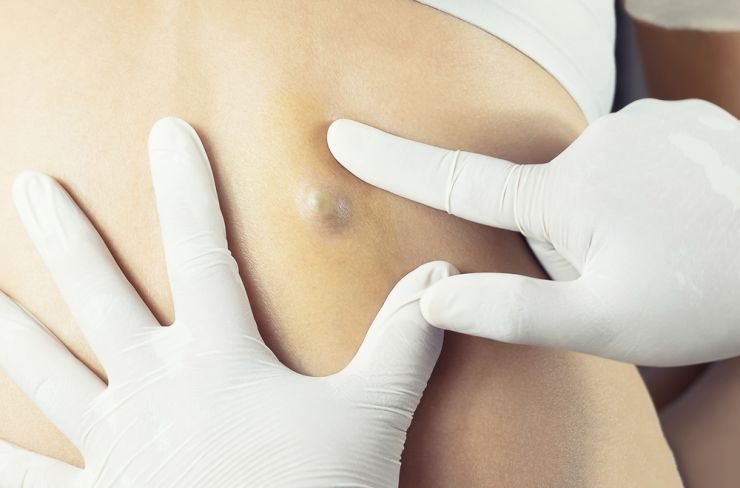Velocity Urgent Care is becoming Sentara Urgent Care
As part of the Sentara family of care, our name will be changing to Sentara Urgent Care on February 3, 2025.
Velocity Urgent Care is becoming Sentara Urgent Care
As part of the Sentara family of care, our name will be changing to Sentara Urgent Care on February 3, 2025.

Cysts have been largely introduced to the public thanks to TLC’s hit reality show “Dr. Pimple Popper.” Although some people can’t stand to watch videos of a cyst treatment happening, they are a common condition that can affect anyone.
Luckily, cyst treatment is an easy process. Knowing the difference between certain types of cysts and when cyst treatment should occur is important for anyone who might be suffering from one or more of them.
In general, a cyst is a closed capsule or sac-like pocket that fills up with fluid much like a blister. The type of fluid it fills with depends on what kind of cyst it is.
The cells that make up the sac of a cyst are different from those around them, but cysts usually aren’t cancerous. They grow slowly over time and don’t typically cause pain. However, a cyst that is left untreated and becomes infected can get sore and may be dangerous.
There are many different types of cysts. They are often classified based on where they appear on the body. For instance, a sebaceous cyst occurs under the skin. Ganglion cysts arise along the tendons and joints of the wrists, hands, and feet. Meanwhile, a baker’s cyst can appear behind the knee.
As mentioned, cysts are very common. They can be caused by a wide variety of things. However, they are most frequently caused by a blockage of the body’s natural ducts.
For example, when a sebaceous (oil) gland is clogged, fluid can build up and cause a cyst under the skin. Other causes of cysts include things like infections, genetic conditions, cellular defects, injuries to blood vessels, and chronic inflammation.
In general, a cyst that is not sore or painful isn’t a medical problem. Many people live with cysts and some may even resolve on their own. Using moist heat compresses on the area multiple times per day can help the body heal a cyst. However, leaving a cyst untreated can also carry some risks.
If it becomes infected, a cyst can quickly turn into an abscess.
When a cyst is left untreated, it may develop into an abscess. Essentially, an abscess is a cyst that is filled with pus rather than normal fluid. It is typically caused by a bacterial infection. This can happen spontaneously or when someone tries to drain a cyst at home and accidentally introduces an infection to the area.
An abscess shows up as a tender area under the skin. The surrounding area usually appears pink or red and may be warm to the touch. A serious abscess can even cause symptoms in other parts of the body such as fatigue, a fever, and decreased appetite. While an abscess needs to be drained by a medical provider, it also requires treatment with antibiotics.
Fortunately, cyst treatment is typically fairly simple. Unless it is a very deep or large cyst, treatment can be performed in the urgent care outpatient setting. A physician will first need to assess the area to determine if care by a specialist is needed. If not, one of two methods can be used to treat cysts.
The first is called fine needle aspiration. After the area is thoroughly numbed, the physician inserts a thin needle into the cyst and drains the fluid. Most patients experience no or little discomfort during the procedure.
For larger cysts and abscesses, the treatment process may require a small incision. After numbing the area, the physician will make a small incision into the cyst or abscess with a scalpel. This allows the fluid or pus to drain. Then, the provider will cleanse the area with a saline solution. Once the procedure is complete, the area is covered with a bandage. It may require more than one visit to completely drain an abscess or cyst if it is large. Finally, the provider will prescribe antibiotics to prevent further infection.
Getting a cyst or abscess treated should be a simple process. Unfortunately, it can take weeks to get an appointment with a primary care doctor or dermatologist and a provider can’t exactly drain a cyst over the telephone. Instead of waiting, you can walk into any Velocity Urgent Care location for quick, safe, and effective treatment.
Our team of board-certified physicians is equipped to treat minor cysts and abscesses on-site. You don’t have to wait for a dermatologist to remove an annoying or unsightly cyst. Velocity Urgent Care has you covered.
In light of the COVID-19 pandemic, we are taking serious safety precautions to ensure that our locations are as clean as possible. We’ve put strict sterilization protocols into place and are carefully handling patients who may be contagious to ensure that each one of our clinics is safe for those who need urgent medical care or testing.
Velocity Urgent Care offers convenient online registration that helps you limit your contact with others during a visit. We even offer text message updates so you can wait in the car until it’s time for your appointment.
Velocity Urgent Care is an in-network provider for most major insurance plans, meaning you can be seen for the cost of your co-pay and deductible. All of our locations also accept Medicare, Medicaid, and Tricare. Veterans Administration beneficiaries are also welcome.